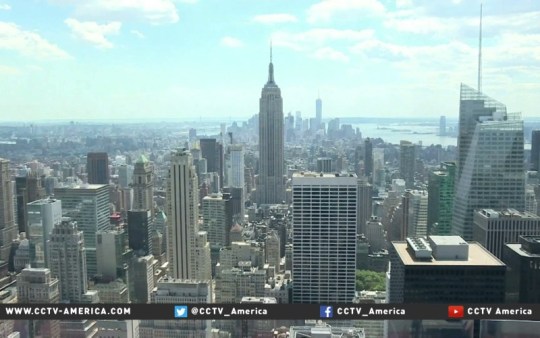A custom-built home in the heart of California’s Silicon Valley had its price cut by $500,000 last week after sitting on the market since the end of March -- a move that would’ve been almost unfathomable a year ago and a signal that frenzied demand has peaked.
The six-bedroom, five-bath house in Palo Alto -- located blocks from Stanford University and the homes of Google co-founder Larry Page and Steve Jobs’s widow, Laurene Powell Jobs -- is now listed for $7.5 million. It joins a growing inventory of high-end homes in the area that are taking longer to sell.
“We’ve recently noticed a slowdown,” Jack Woodson, who works at Alain Pinel Realtors in nearby Menlo Park, said on a tour of the house in the Old Palo Alto neighborhood. “Buyers are taking more time to decide about making offers.”
Silicon Valley, the most-expensive U.S. housing market, is seeing a pullback by the wealthiest homebuyers after a four-year real estate boom marked by bidding wars and multimillion-dollar prices. Stock-market turmoil, a drop in foreign investors and concerns of a technology-industry slowdown are cooling demand at the high end, even as interest remains robust for more moderately priced properties.
In Palo Alto, an ultra-wealthy city that’s home to many Google and Facebook Inc. executives, homes costing more than $5 million were on the market for a median of 16 days in April, compared with 11 in the same month in 2015 and 10 in 2014, according to data from Irvine, California-based John Burns Real Estate Consulting. The 11 active listings in that price range as of May 14 have been on the market a median of 30 days.
While that’s quick by most standards -- across the U.S., the median time on the market is 67 days -- it’s a departure from recent years, when newly minted millionaires from tech initial public offerings raced against buyers from
China to scoop up anemic inventory.
“The seemingly inexhaustible well of very high-end buyers has proven exhaustible after all,” said Dean Wehrli, a senior vice president at John Burns. “The peak is behind us, and that’s becoming clearer and clearer to builders and buyers.”
Pricey Properties
The San Jose metropolitan area, encompassing Silicon Valley, is the most expensive U.S.
housing market, with a median single-family home price of $970,000, according to the National Association of Realtors. In Palo Alto, the median home price was $2.5 million in the first quarter, data from Zillow show. That’s higher than San Francisco, at $1.1 million, and New York, at $616,100.
Across the country, luxury-home sales are
cooling as turmoil in the global economy and the prospect of higher interest rates roils financial markets. Silicon Valley has the added pressures of being closely correlated to the tech industry and a top target for foreign buyers.
Venture-capital investments in Silicon Valley fell almost 20 percent in the first quarter from a year earlier to $4.9 billion, according to an April
report from PricewaterhouseCoopers LLP. Chinese buyers -- hit by a slowing economy and government restrictions on how much money can leave the country -- have slowed purchases after they had “really been driving the market,” said Woodson of Alain Pinel.
“We’re probably moving toward normalization,” said Katharine Carroll, vice president at
Pacific Union Real Estate in Palo Alto. “Buyers see that they have a few more options. They don’t feel the urgency that they have to decide on something right away and put an offer in. They can kick the tires a little bit more.”
Statewide Slower
The sale of luxury real estate is slowing statewide, with homes costing more than $3 million sitting on the market 52.5 days in the first quarter, compared with 40 days the year before, said Jordan Levine, an economist at the California Association of Realtors in Los Angeles.
In Santa Clara County, home to Palo Alto, there were 13 sales of homes costing more than $5 million in the first quarter, down from 20 a year earlier, he said. In nearby Los Altos, there were six active listings of homes costing more than $5 million on the market for a median of 25.5 days as of May 14, while the 25 listings in Atherton were on the market a median of 100 days, according to John Burns.
“Given that a larger proportion of the $3 million-plus category is purchased with cash, or folks use some of their other assets to make those kinds of purchases, I think they’re more susceptible to stock-market volatility than your entry-level buyer would be,” Levine said. “That’s one of the big drivers of the current slowdown.”
Mid-Range Demand
There’s no let-up in the demand for homes in the $2 million to $3 million range. Realtors say those properties are still generating multiple offers and selling above asking prices because they are still affordable to software engineers. Aggressive hiring at Facebook and Google is propping up the middle segment of the housing market in Silicon Valley, said Ken DeLeon, founder of DeLeon Realty in Palo Alto.
“Palo Alto is at a crossroads, where some homes are doing very well, and some homes are lingering that last year would have sold with multiple offers,” DeLeon said. “When they do sell, it’s when the seller cuts the price below what they would have gotten last year.”
High-end buyers are pickier and are more likely to let a property go, instead of competing with multiple offers and an auction dynamic that led to homes selling well above asking price until very recently, he said.
“I’m having buyers who are much more open to waiting, to taking a risk that the home might sell,” he said. “There’s just not that motivation.”

